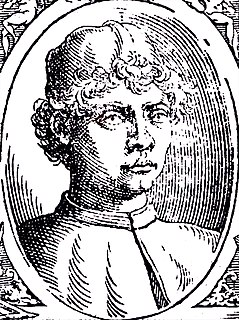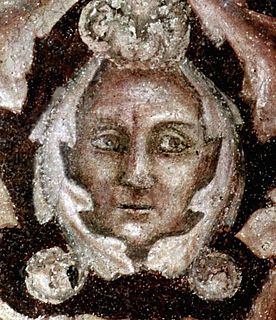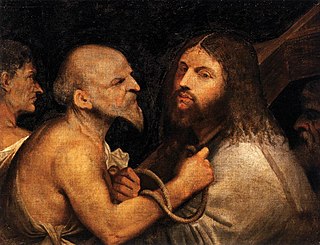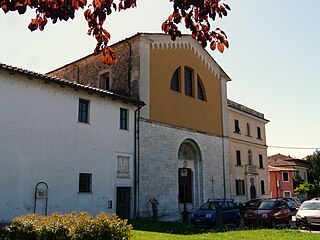
Piero della Francesca was an Italian painter of the Early Renaissance. As testified by Giorgio Vasari in his Lives of the Most Excellent Painters, Sculptors, and Architects, to contemporaries he was also known as a mathematician and geometer. Nowadays Piero della Francesca is chiefly appreciated for his art. His painting is characterized by its serene humanism, its use of geometric forms and perspective. His most famous work is the cycle of frescoes The History of the True Cross in the church of San Francesco in the Tuscan town of Arezzo.

Udine is a city and comune in north-eastern Italy, in the middle of the Friuli-Venezia Giulia region, between the Adriatic Sea and the Alps. Its population was 100,514 in 2012, 176,000 with the urban area.

Antonello da Messina, properly Antonello di Giovanni di Antonio, but also called Antonello degli Antoni and Anglicized as Anthony of Messina, was an Italian painter from Messina, Sicily, active during the Early Italian Renaissance. His work shows strong influences from Early Netherlandish painting although there is no documentary evidence that he ever travelled beyond Italy. Giorgio Vasari credited him with the introduction of oil painting into Italy. Unusually for a south Italian artist of the Renaissance, his work proved influential on painters in northern Italy, especially in Venice.

The Accademia di Belle Arti di Firenze is an instructional art academy in Florence, in Tuscany, in central Italy.

Antonio Pigafetta was an Italian scholar and explorer from the Republic of Venice. He traveled with the Portuguese explorer Ferdinand Magellan and his crew by order of the King Charles I of Spain on their voyage around the world. During the expedition, he served as Magellan's assistant and kept an accurate journal which later assisted him in translating the Cebuano language. It is the first recorded document concerning the language.

Rovereto is a city and comune in Trentino in northern Italy, located in the Vallagarina valley of the Adige River.

Cennino d'Andrea Cennini was an Italian painter influenced by Giotto. He was a student of Agnolo Gaddi in Florence. Gaddi trained under his father, called Taddeo Gaddi, who trained with Giotto.

Antoniazzo Romano, born Antonio di Benedetto Aquilo degli Aquili was an Italian Early Renaissance painter, the leading figure of the Roman school during the 15th century.

Saint Veridiana is an Italian saint.

Vittorio Umberto Antonio Maria Sgarbi is an Italian art critic, art historian, politician, cultural commentator and television personality. In 1996 he was condemned for fraud against the Italian State. He was appointed curator of the Italian Pavilion at the 2011 Venice Biennale. Several times a member of the Italian Parliament, he served also in Milan's municipal government.
Dante da Maiano was a late thirteenth-century poet who composed mainly sonnets in Italian and Occitan. He was an older contemporary of Dante Alighieri and active in Florence.

Giotto di Bondone, known mononymously as Giotto and Latinised as Giottus, was an Italian painter and architect from Florence during the Late Middle Ages. He worked during the Gothic/Proto-Renaissance period.

Christ Carrying the Cross is a 1505 oil painting attributed to either the Italian Renaissance master Titian or Giorgione. It is located in the Scuola Grande di San Rocco in Venice, Italy.

Galileo Chini was an Italian decorator, designer, painter, and potter. A prominent member of the Italian Art nouveau movement, he taught decorative arts at the Accademia di Belle Arti in Florence. He was responsible for several of the paintings and decorations in the Brandini Chapel at Castelfiorentino, the church of San Francesco de' Ferri in Pisa, and the Ananta Samakhom Throne Hall in Bangkok. His theatrical work included designing the sets for the European premiere of Puccini's opera Gianni Schicchi and the world premiere of his Turandot. He also created the sets for the premieres of Umberto Giordano's opera La cena delle beffe and Sem Benelli's play of the same name on which the opera was based.

The Galleria d'Arte Moderna is a modern art museum in Milan, in Lombardy in northern Italy. It is housed in the Villa Reale, at Via Palestro 16, opposite the Giardini Pubblici. The collection consists largely of Italian and European works from the 18th to the 20th centuries.
The Museo Ideale Leonardo da Vinci is located in Vinci, Leonardo da Vinci's birthplace, in the province of Florence, Italy.
Ernesto Treccani, Italian painter and intellectual. Born in Milan on August 26, 1920, he joined very early the art avant-garde groups and movements opposed to Fascist culture. Founder and director at the age of 18 of the magazine "Corrente", he exhibited his first works at the "Bottega di Corrente" with Renato Birolli, Renato Guttuso, Giuseppe Migneco, Aligi Sassu and later with Bruno Cassinari and Ennio Morlotti at Galleria della Spiga and Corrente.

San Francesco is a Roman Catholic church and monastery located in Sarzana, region of Liguria, Italy.
Ferruccio Ferrazzi was an Italian painter and sculptor as well as a professor at Accademia di Belle Arti of Rome.)
Orazio Bacci was an Italian Liberal Party politician. He was the 12th mayor of Florence, Kingdom of Italy. He died in Rome.



















